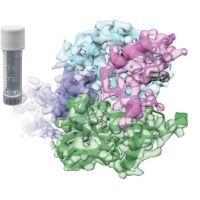Specification
| Description | Recombinant protein from the full-length sequence of Homo sapiens DEAH-box helicase 36 (DHX36), transcript variant 1 (NM_020865). |
| Organism | Homo sapiens (Human) |
| Expression Host | Human Cells |
| Tag Info | His or DYKDDDDK. Please contact us if you need further information or require specific designed tag. |
| Purity | Greater than 90% by SDS-PAGE gel |
| Uniprot ID | Q9H2U1 |
| Entry Name | DHX36_HUMAN |
| Gene Names | DHX36 DDX36 KIAA1488 MLEL1 RHAU |
| Alternative Gene Names | DDX36 KIAA1488 MLEL1 RHAU |
| Alternative Protein Names | ATP-dependent DNA/RNA helicase DHX36 (EC 3.6.4.12) (EC 3.6.4.13) (DEAD/H box polypeptide 36) (DEAH-box protein 36) (G4-resolvase-1) (G4R1) (MLE-like protein 1) (RNA helicase associated with AU-rich element protein) |
| Application | Antigens, Western, ELISA and other in vitro binding or in vivo functional assays, and protein-protein interaction studies; For research & development use only! |
| Buffer | Purified protein formulated in a sterile solution of PBS buffer, pH7.2, without any preservatives |
| Endotoxin | Endotoxin level is < 0.1 ng/µg of protein (<1EU /µg) |
| Length | 1008 |
| Molecular Weight(Da) | 114760 |
| Protein Sequence | (The sequence of expressed protein may have some variation from the sequence shown below. Please contact us for the exact sequence.) MSYDYHQNWGRDGGPRSSGGGYGGGPAGGHGGNRGSGGGGGGGGGGRGGRGRHPGHLKGREIGMWYAKKQGQKNKEAERQERAVVHMDERREEQIVQLLNSVQAKNDKESEAQISWFAPEDHGYGTEVSTKNTPCSENKLDIQEKKLINQEKKMFRIRNRSYIDRDSEYLLQENEPDGTLDQKLLEDLQKKKNDLRYIEMQHFREKLPSYGMQKELVNLIDNHQVTVISGETGCGKTTQVTQFILDNYIERGKGSACRIVCTQPRRISAISVAERVAAERAESCGSGNSTGYQIRLQSRLPRKQGSILYCTTGIILQWLQSDPYLSSVSHIVLDEIHERNLQSDVLMTVVKDLLNFRSDLKVILMSATLNAEKFSEYFGNCPMIHIPGFTFPVVEYLLEDVIEKIRYVPEQKEHRSQFKRGFMQGHVNRQEKEEKEAIYKERWPDYVRELRRRYSASTVDVIEMMEDDKVDLNLIVALIRYIVLEEEDGAILVFLPGWDNISTLHDLLMSQVMFKSDKFLIIPLHSLMPTVNQTQVFKRTPPGVRKIVIATNIAETSITIDDVVYVIDGGKIKETHFDTQNNISTMSAEWVSKANAKQRKGRAGRVQPGHCYHLYNGLRASLLDDYQLPEILRTPLEELCLQIKILRLGGIAYFLSRLMDPPSNEAVLLSIRHLMELNALDKQEELTPLGVHLARLPVEPHIGKMILFGALFCCLDPVLTIAASLSFKDPFVIPLGKEKIADARRKELAKDTRSDHLTVVNAFEGWEEARRRGFRYEKDYCWEYFLSSNTLQMLHNMKGQFAEHLLGAGFVSSRNPKDPESNINSDNEKIIKAVICAGLYPKVAKIRLNLGKKRKMVKVYTKTDGLVAVHPKSVNVEQTDFHYNWLIYHLKMRTSSIYLYDCTEVSPYCLLFFGGDISIQKDNDQETIAVDEWIVFQSPARIAHLVKELRKELDILLQEKIESPHPVDWNDTKSRDCAVLSAIIDLIKTQEKATPRNFPPRFQDGYYS |
Background
| Function | FUNCTION: Multifunctional ATP-dependent helicase that unwinds G-quadruplex (G4) structures (PubMed:16150737, PubMed:18854321, PubMed:20472641, PubMed:21586581). Plays a role in many biological processes such as genomic integrity, gene expression regulations and as a sensor to initiate antiviral responses (PubMed:14731398, PubMed:18279852, PubMed:21993297, PubMed:22238380, PubMed:25579584). G4 structures correspond to helical structures containing guanine tetrads (By similarity). Binds with high affinity to and unwinds G4 structures that are formed in nucleic acids (G4-ADN and G4-RNA) (PubMed:16150737, PubMed:18842585, PubMed:20472641, PubMed:21586581, PubMed:24369427, PubMed:26195789). Plays a role in genomic integrity (PubMed:22238380). Converts the G4-RNA structure present in telomerase RNA template component (TREC) into a double-stranded RNA to promote P1 helix formation that acts as a template boundary ensuring accurate reverse transcription (PubMed:20472641, PubMed:21149580, PubMed:21846770, PubMed:22238380, PubMed:24151078, PubMed:25579584). Plays a role in transcriptional regulation (PubMed:21586581, PubMed:21993297). Resolves G4-DNA structures in promoters of genes, such as YY1, KIT/c-kit and ALPL and positively regulates their expression (PubMed:21993297). Plays a role in post-transcriptional regulation (PubMed:27940037). Unwinds a G4-RNA structure located in the 3'-UTR polyadenylation site of the pre-mRNA TP53 and stimulates TP53 pre-mRNA 3'-end processing in response to ultraviolet (UV)-induced DNA damage (PubMed:27940037). Binds to the precursor-microRNA-134 (pre-miR-134) terminal loop and regulates its transport into the synapto-dendritic compartment (By similarity). Involved in the pre-miR-134-dependent inhibition of target gene expression and the control of dendritic spine size (By similarity). Plays a role in the regulation of cytoplasmic mRNA translation and mRNA stability (PubMed:24369427, PubMed:26489465). Binds to both G4-RNA structures and alternative non-quadruplex-forming sequence within the 3'-UTR of the PITX1 mRNA regulating negatively PITX1 protein expression (PubMed:24369427). Binds to both G4-RNA structure in the 5'-UTR and AU-rich elements (AREs) localized in the 3'-UTR of NKX2-5 mRNA to either stimulate protein translation or induce mRNA decay in an ELAVL1-dependent manner, respectively (PubMed:26489465). Binds also to ARE sequences present in several mRNAs mediating exosome-mediated 3'-5' mRNA degradation (PubMed:14731398, PubMed:18279852). Involved in cytoplasmic urokinase-type plasminogen activator (uPA) mRNA decay (PubMed:14731398). Component of a multi-helicase-TICAM1 complex that acts as a cytoplasmic sensor of viral double-stranded RNA (dsRNA) and plays a role in the activation of a cascade of antiviral responses including the induction of proinflammatory cytokines via the adapter molecule TICAM1 (By similarity). Required for early embryonic development and hematopoiesis. Involved in the regulation of cardioblast differentiation and proliferation during heart development. Involved in spermatogonia differentiation. May play a role in ossification (By similarity). {ECO:0000250|UniProtKB:D4A2Z8, ECO:0000250|UniProtKB:Q05B79, ECO:0000250|UniProtKB:Q8VHK9, ECO:0000269|PubMed:14731398, ECO:0000269|PubMed:16150737, ECO:0000269|PubMed:18279852, ECO:0000269|PubMed:18842585, ECO:0000269|PubMed:18854321, ECO:0000269|PubMed:20472641, ECO:0000269|PubMed:21149580, ECO:0000269|PubMed:21586581, ECO:0000269|PubMed:21846770, ECO:0000269|PubMed:21993297, ECO:0000269|PubMed:22238380, ECO:0000269|PubMed:24151078, ECO:0000269|PubMed:24369427, ECO:0000269|PubMed:25579584, ECO:0000269|PubMed:26195789, ECO:0000269|PubMed:26489465, ECO:0000269|PubMed:27940037}. |
| Pathway | |
| Protein Families | DEAD box helicase family, DEAH subfamily |
| Tissue Specificity | Highly expressed in testis. {ECO:0000269|PubMed:12198572, ECO:0000269|PubMed:14731398}. |
QC Data
| Note | Please contact us for QC Data |
| Product Image (Reference Only) |  |

